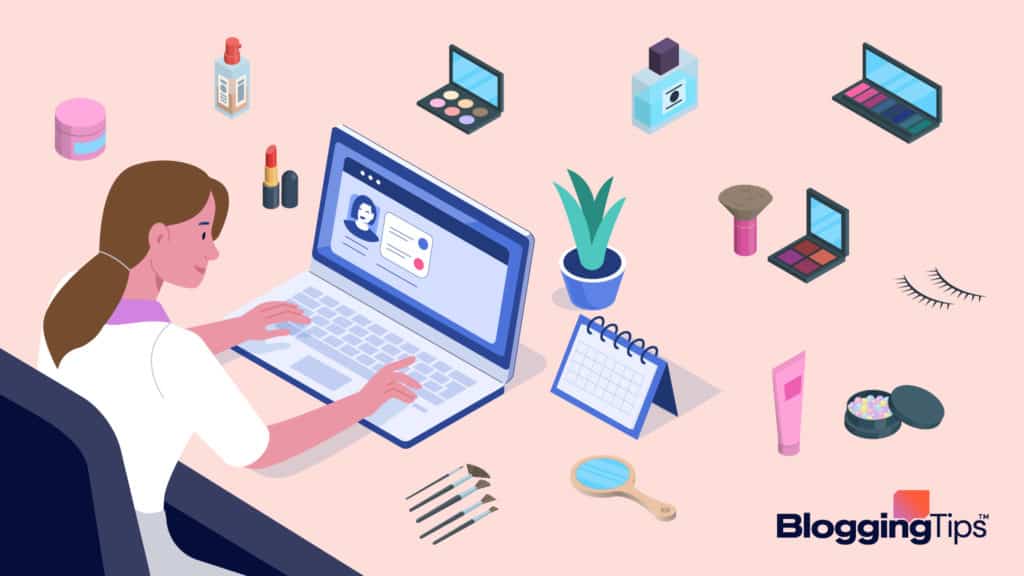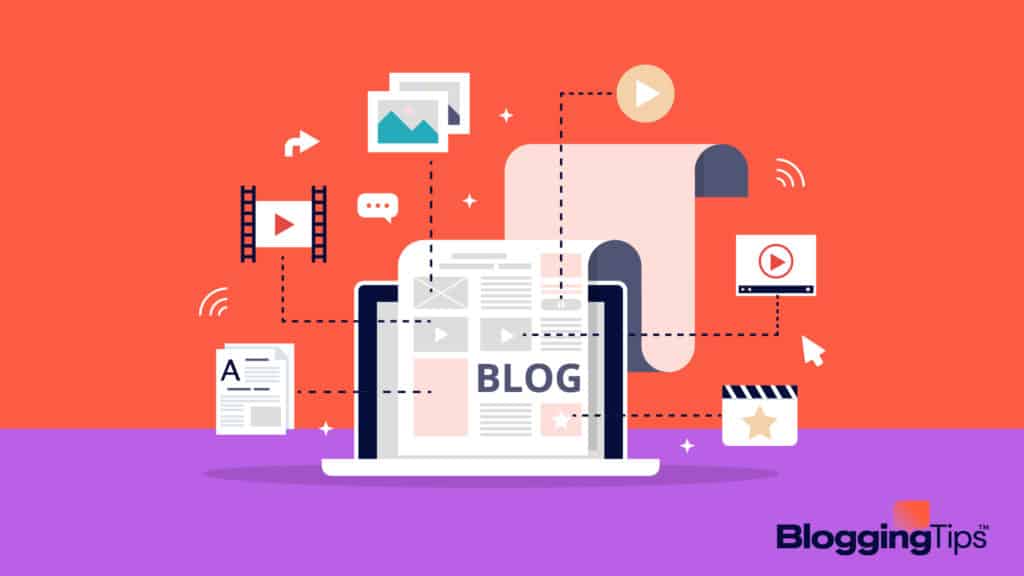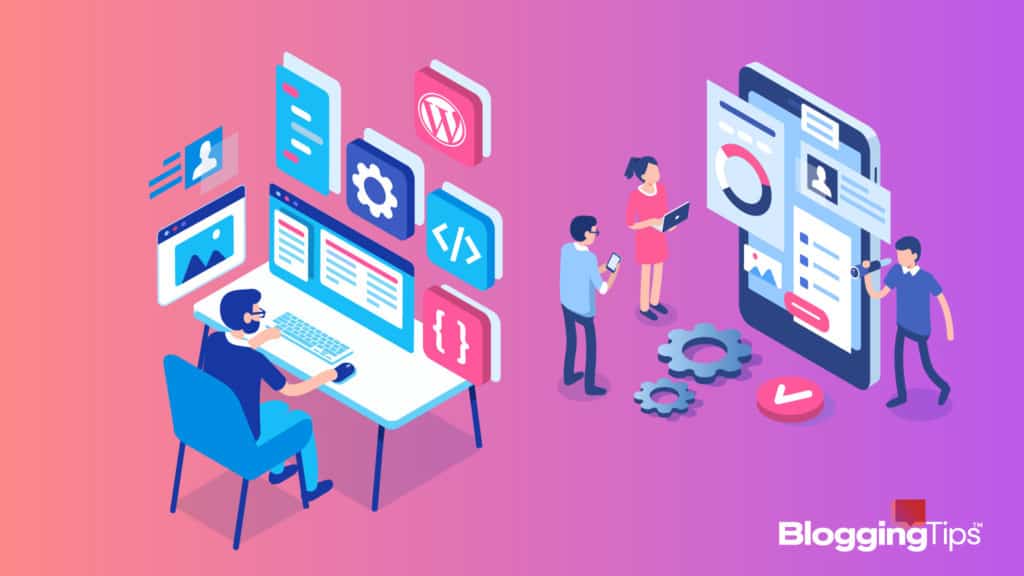The first blog appeared in 1994.
Close to three decades later, blogging has taken over the Internet.
The popularity of blogging provides many advantages for businesses and entrepreneurs.
Blogging may help you nurture sales leads and retain more customers.
So what exactly is blogging, and why does it matter?
The following guide provides a complete breakdown of the typical blog, such as the core elements every blog needs to succeed.
Contents
- Overview of Blogging: The Basics
- History of Blogging
- Elements of a Blog
- Blogging vs. Websites: Similarities and Differences
- Blogging vs. Vlogging: Similarities and Differences
- Pros and Cons of Blogging
- Common Types of Blogs
- The Most Popular Platforms for Blogging
- How Do Bloggers Make Money?
- What Is Needed to Start Blogging?
- Wrapping Up
Overview of Blogging: The Basics
You should first understand the basics of blogging, including what it is and how it works.

What is Blogging?
Blogging involves publishing blog posts on a blog.
A blog is a website that receives frequent updates with posts designed to provide helpful information on a specific topic.
Blogs may be used for personal or business purposes.
Personal blogs often revolve around lifestyle topics, such as health and fitness or hobbies.
Business blogs often promote products or services and help build trust with potential customers.
How Does Blogging Work?
Bloggers research, write, and revise content before publishing it on their blogs.
They then share the content to reach new and existing followers.
Why is Blogging So Popular?
The popularity of blogs comes from their ability to provide people with solutions or useful information.
People of all skill levels can also create websites and post content, which makes blogging highly accessible.
Businesses and entrepreneurs have used blogs to attract web traffic and nurture sales leads.
The use of business blogs has made blogging essential for most modern businesses.
History of Blogging
Links.net was the first blog. Justin Hall created the blog in 1994 to review HTML examples.
Within a few years, thousands of others started publishing content on their own sites.
In 1997, Jorn Barger used the term “weblog” to describe the original blogs.
In 1999, Peter Morholz shortened the term to “blog.”
The Blogger platform launched the same year.
Blogs were gaining in popularity as the Internet exploded in use in the early 2000s.
Blogs soon filled a large portion of the Internet.
However, blogs have changed over the years.
Blogs Then Versus Blogs Now
The original blogs were personal “open diaries.”
Most of the early bloggers published stories from their daily lives.
Instead of personal blogs documenting peoples’ daily lives, the most popular blogs are now the ones that provide useful content.
News blogs, hobby blogs, and business blogs attract the most visitors.
The first blogs were mostly just a collection of personal posts.
Modern blogs are typically full-blown websites with category pages and more.
Elements of a Blog
The typical blog includes several core pages, individual category pages, and a growing selection of blog posts.
Here is a closer look at each of these elements.

Core Pages of a Blog
The core pages of a blog are the pages that you need to help users navigate your site, provide contact information, and cover your legal responsibilities.
The core pages include:
- Homepage
- About us
- Privacy policy and terms of use
- Contact us
1. Homepage
The homepage is the default front page of a website.
When a user types in the URL to a domain name, they may be directed to the homepage.
It acts as a starting point for exploring the rest of the website.
Some of the elements found on the typical blog homepage include:
- Recent posts
- Popular posts
- Post Categories
- Navigational menu
- Social media links
- Subscribers sign up form or link
The homepage for a blog often includes a preview or list of recent posts, making it easy for visitors to find the latest content.
2. About Us Page
The “About Us” page provides an overview of what your website offers and your mission.
This page helps people create a personal connection with your blog.
A quality “About Us” page can help differentiate your brand from the competition.
Use this page to share what makes your business different.
An “About Us” page may include a short introduction and overview of what the blog is about.
A mission statement is included to provide a summary of your values and overall goals.
It explains what you hope to achieve with your blog.
You may also want to include a brief bio for yourself and any core members of your team.
3. Privacy Policy and Terms of Use Pages
Privacy policies and terms of use (TOS) pages are necessary for all websites.
The privacy policy explains what type of data you collect from visitors.
You need to let people know what type of information you are collecting to comply with the data privacy laws in most countries.
A terms of use (TOS) page is not typically required by law.
However, it can help protect your rights by limiting your liability should someone misuse the information on your website.
For example, you would not want to be held liable for someone following your financial advice from a financial blog.
You can use an online privacy generator tool and TOS generator tool to quickly create these pages for your blog.
4. Contact Us Page
The “Contact Us” page helps visitors get in touch with you.
It may include multiple methods for reaching you or someone at your organization.
Common items on a contact page include:
- Email addresses
- Telephone numbers
- Postal addresses
- Social media links
- Online contact forms
You may find it difficult to climb the search rankings without including contact information on your blog.
Websites without a valid email address or telephone number may get flagged as potential spam.
People are also less likely to trust a blog that does not provide any method for contacting the owners.
While you may not need a telephone number, you should at least include an email address.
Category Pages
Category pages help visitors navigate your blog and find the content that they want.
Along with categories, many blogs use tags to provide even more navigation options.
Categories help group together posts with similar topics.
Tags help group posts based on subtopics and specific details.
Blog Posts
Blog posts are online articles published on blogs.
Each blog post focuses on a single topic or query.
A blog may contain dozens, hundreds, or even thousands of blog posts.
Blogging vs. Websites: Similarities and Differences
A blog is a type of website. However, a traditional website is typically considered a static site.
The content mostly remains the same instead of receiving frequent updates.
Examples of traditional websites include business websites and e-commerce websites.
Blogs are updated regularly with new blog posts.
The focus of the blog is to direct readers to the blog posts instead of a product or service page.
Blogging vs. Vlogging: Similarities and Differences
Vlogging (video blogging) is a form of blogging that involves publishing videos.
Vlogs contain many of the same elements as blogs, including a homepage, contact page, and about us page.
However, the posts include videos instead of articles with written text.
Pros and Cons of Blogging

Pros of Blogging
- You can start blogging without a significant investment. You may even start with a free blogging platform.
- Blogging helps drive traffic to other pages, such as product and service pages.
- Anyone can learn to start blogging. You do not need any technical experience.
- Blogging may open the doors to other opportunities. You may make connections that can help with other business paths.
- Blogging can be fun when you choose a topic that you love.
- Creating a blog may generate a decent passive income.
- Blogging may eventually replace other sources of income, such as your current job.
Cons of Blogging
- Requires a commitment. You need to continue publishing new content to keep people interested.
- You will not get results overnight.
- Some niche markets are already oversaturated, making it difficult for new blogs to compete.
- Dealing with technical issues can be frustrating and time-consuming.
- You cannot guarantee success.
- Blogging may take time away from other responsibilities.
- You may need to outsource tasks to keep your blog active.
Common Types of Blogs
Here is a review of some of the most common types of blogs.
Hobby Blog
A hobby blog is a blog dedicated to exploring a specific hobby, such as gardening or working out.
These blogs often include tutorials and advice to help hobbyists with their hobbies.
Ranting & Raving Blog
Ranting and raving blogs try to leverage people’s emotions to attract readership.
These types of blogs include posts that are emotionally charged and designed to elicit strong reactions.
Business Blog
A business blog typically includes informative articles related to the products or services offered by the business that manages the blog.
Creating a business blog can help businesses attract more interest in their offerings.
Affiliate Blog
Affiliate blogs promote products or services.
The blogger receives a commission when visitors purchase a product or service after following an affiliate link.
Influencer Blog
Influencer blogs often generate money through sponsored posts and advertisements.
These types of blogs are also often personal blogs focused on lifestyle topics.
The Most Popular Platforms for Blogging
You can use a paid or free blogging platform to create your blog and publish posts.
Here are some of the top recommendations for both options.

3 Best Free Blogging Platforms
- WordPress offers access to tens of thousands of templates, themes, and plugins for customizing every aspect of your blog. You can also find user-friendly tutorials that walk you through every step of creating a blog on WordPress.
- Wix provides a simple-to-use interface, which is great for those who are not comfortable with technology. It also offers access to useful services, including email marketing services.
- Weebly is another easy-to-use blogging platform with a free plan. You can also add e-commerce features for free.
3 Best Paid Blogging Platforms
- Squarespace is a paid website platform focused on e-commerce. However, you can also use the platform to create responsive, easy-to-browse blogs.
- Substack is a unique blogging platform that allows you to publish content for free with unlimited subscribers. However, the company charges a commission for paid subscriptions.
- Wix offers paid plans, along with its free plan. Upgrading to a paid plan offers access to more templates and features for helping your blog stand out.
How Do Bloggers Make Money?
Bloggers make money using one or more of the following:
- Advertisements
- Affiliate marketing
- Sponsored posts
- E-commerce
The most common sources of income for bloggers include advertisements and affiliate marketing.
Bloggers make money when visitors follow links to other sites.
How Much Do Bloggers Make?
The average income for a blogger is about $37,073.
However, the amount they earn depends on a variety of actors, including the size of their target audience and the amount of traffic that their blogs receive.
What Is Needed to Start Blogging?
Starting a blog requires several components.
Here is a rundown of what you need to start blogging.
1. A Topic You Love
Blogging about a topic that you love makes it easier to continue generating new content.
You are also more likely to produce quality content when you choose a topic that you are passionate about and knowledgeable about.
2. Blogging Platform
As discussed, a blogging platform offers a simple way for anyone to start posting blogs online.
You can choose from templates and premade themes to quickly build a website and publish new blog posts.
3. Domain Name
The domain name is one of the most important elements of a blog.
You can use a free blogging platform without owning a domain name.
However, a domain name adds authenticity to your blog.
It helps to choose a domain name that users can easily remember.
It should also match the name of your blog for greater consistency and brand recognition.
4. Blog Hosting
While free blogging platforms can help you get started, you will eventually need a paid web hosting plan to support your growing website.
Inexpensive shared hosting costs just $5 to $15 per month.
As the size of your audience grows, you can consider upgrading your hosting plan.
5. Content
You cannot have a blog without content.
Your content may include written articles, videos, or infographics.
According to Zippia, the average blog post length is about 1,416 words.
You may want to take the time to populate your blog with a variety of articles before you start promoting it, which gives your readers more content to browse.
6. Patience & Persistence
Creating a successful blog does not happen overnight.
It may take a year or longer to generate a sizable income with a blog.
You need to gradually build your audience and keep people coming back for more.
Wrapping Up
Blogging is the process of publishing original content to a blog.
Creating and maintaining a blog could be the key to the success of your business or providing an additional income stream.
If you have any questions, please feel free to leave a comment below.
Blogging offers many advantages for businesses, as it helps you generate more leads and keep your audience updated about your products or services.
Set up a blog and start posting original content if you want to maximize your business potential.




